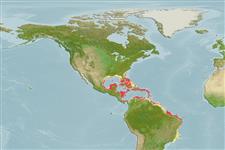Common names from other countries
Teleostei (teleosts) >
Eupercaria/misc (Various families in series Eupercaria) >
Haemulidae (Grunts) > Haemulinae
Etymology: Haemulon: Greek, haimaleos = bloody (Ref. 45335).
More on author: Cuvier.
Environment: milieu / climate zone / depth range / distribution range
Ecology
Marine; reef-associated; depth range 20 - 60 m (Ref. 5217). Tropical; 33°N - 33°S, 99°W - 30°W
Western Atlantic: Florida Keys (USA), Bermuda, and Bahamas to Brazil. Found throughout the West Indies; absent in Colombia (Ref. 3798).
Length at first maturity / Size / Weight / Age
Maturity: Lm 30.5, range 30 - ? cm
Max length : 79.0 cm TL male/unsexed; (Ref. 40637); common length : 50.0 cm TL male/unsexed; (Ref. 5217); max. published weight: 7.1 kg (Ref. 40637)
Dorsal spines (total): 12; Dorsal soft rays (total): 15 - 17; Anal spines: 3; Anal soft rays: 7 - 8. Scale rows immediately below lateral line oblique (Ref. 26938). Usual color phase dull silvery, the fins largely gray; no black pigment below upper margin of preopercle; the dorsal and caudal fins of subadults and the back above a line from dorsal base to lower margin of caudal fin are often blackish (Ref. 13442).
Inhabits seagrass beds, sand flats, coral reefs, and wrecks (Ref. 9710). Found in pairs or larger schools (Ref. 3798). Feeds on benthic invertebrates (Ref. 3798). Has been observed to nose into the sand to eat such subsurface invertebrates as peanut worms and heart urchins (Ref. 13442). Marketed fresh (Ref. 3798).
Oviparous, distinct pairing during breeding (Ref. 205).
Cervigón, F., 1993. Los peces marinos de Venezuela. Volume 2. Fundación Científica Los Roques, Caracas,Venezuela. 497 p. (Ref. 9626)
IUCN Red List Status (Ref. 130435)
CITES (Ref. 128078)
Not Evaluated
Threat to humans
Reports of ciguatera poisoning (Ref. 30303)
Human uses
Fisheries: commercial; gamefish: yes; aquarium: public aquariums
Tools
Special reports
Download XML
Internet sources
Estimates based on models
Preferred temperature (Ref.
115969): 21.1 - 27.6, mean 25 (based on 110 cells).
Phylogenetic diversity index (Ref.
82804): PD
50 = 0.5000 [Uniqueness, from 0.5 = low to 2.0 = high].
Bayesian length-weight: a=0.01202 (0.00775 - 0.01866), b=3.00 (2.87 - 3.13), in cm Total Length, based on LWR estimates for this species & Genus-body shape (Ref.
93245).
Trophic level (Ref.
69278): 3.3 ±0.1 se; based on diet studies.
Resilience (Ref.
120179): Medium, minimum population doubling time 1.4 - 4.4 years (K=0.19-0.20; tm=3.5; Fec=800,000).
Fishing Vulnerability (Ref.
59153): Moderate vulnerability (45 of 100).
